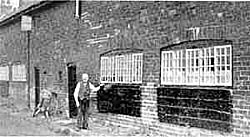< Previous | Contents | Next >
Calverton: stockingers' cottages
 |
CALVERTON is a pleasant enough village situated amidst rural surroundings, and there is little about it to advertise the fact that it was the birthplace of one of the most important of modern industries. But Calverton still makes hosiery, and the large windows shown in this picture were so constructed as to allow for a maximum of light to fall upon the hand-frames, whose clatter in bygone days filled the village with cheerful noise.
A specimen of one of these frames can be seen in Nottingham Castle Museum, and it is a very different affair from the huge and complicated modern hosiery machines which abound in our factories nowadays.
The story of the Rev. William Lee, inventor of the stocking frame, is pathetic. He was born in 1563 in Calverton, and received sufficient education to fit him for the University, for in 1579 he was at Christ’s College, Cambridge, and later removed to St. John’s College in the same University.
Having taken his degree as Master of Arts he returned home, and became curate of either Woodborough or Calverton. But he was desperately poor for his income from each parish was only £20 per annum. Mrs. Lee, therefore, had to help to finance the household and she earned money by knitting.
Lee was of a mechanical turn of mind, and by closely watching the movements of his wife’s fingers while knitting, he was at last able to reproduce these movements by machinery. His tools were of the crudest, and his machine was made entirely of wood, for iron was expensive and hard to come by. Moreover the material knitted was the wool spun from the fleeces of the local sheep, for cotton was almost unprocurable at Calverton in the days when Lee was alive.
As the population of Calverton in Lee’s days was about 200, there was little scope for the new machine, and so Lee removed to London. Fancy the misery of that journey: Lee, his wife and his family, with their pathetic household goods, undertaking the 150 miles walk (for they were so poor that they could not afford to go by wagon) over the awful thief-infested roads of those days.
Fresh disappointment met Lee in London. Both Queen Elizabeth and King James I. inspected the machine, and although they were impressed they refused to grant a patent.
But the French Ambassador promised that the King of France would grant a patent, and so the machine was removed to Rouen, But before anything could be done the King of France was assassinated, and all hope was lost, and poor Lee died in penury of a broken heart and lies buried in an unknown grave.
